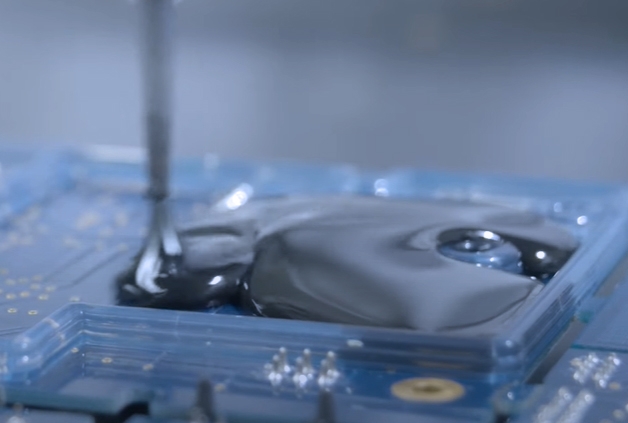Connecting Excellence: The Evolution of Epoxy Adhesive Components

In the realm of adhesive technologies, the evolution of epoxy adhesives has
been nothing short of revolutionary. As industries continue to demand stronger,
more resilient bonding solutions, two-component epoxy adhesives have risen to
the occasion, becoming the cornerstone of modern bonding applications. This
article delves into the intricacies of two-component epoxy adhesives, exploring
their multifaceted applications, with a focus on epoxy
potting compounds for electronics and the cutting-edge DeepMaterial
underfill epoxy.
The Rise of Two-Component Epoxy Adhesives
Two-component epoxy adhesives have become the gold standard for many
industrial applications due to their exceptional strength, durability, and
versatility. Comprising a resin and hardener that are mixed in specific ratios,
these adhesives undergo a chemical reaction upon blending, transforming into a
robust and resilient bond. This chemical curing process sets them apart from
their one-component counterparts, offering enhanced performance and
reliability.
One of the key advantages of two-component epoxy adhesives is their ability
to bond diverse materials, ranging from metals and ceramics to plastics and
composites. This versatility has made them indispensable in various industries,
including aerospace, automotive, electronics, and construction.
Epoxy Potting Compounds for Electronics
Electronics have witnessed a paradigm shift in design and functionality over
the years, and with it, the demand for reliable and efficient potting compounds
has surged. Epoxy potting compounds have emerged as the go-to solution for
encapsulating and protecting electronic components from environmental factors,
mechanical stress, and chemical exposure.
These potting compounds provide a protective barrier against moisture, dust,
and other contaminants, ensuring the longevity and performance of delicate
electronic assemblies. The two-component nature of epoxy potting compounds
allows for precise mixing, ensuring optimal performance and adherence to
stringent industry standards.
Moreover, the thermal conductivity of epoxy potting compounds is a crucial
factor in electronic applications. These compounds efficiently dissipate heat
generated by electronic components, preventing overheating and enhancing the
overall reliability of electronic devices.
In the rapidly evolving electronics industry, where miniaturization and
performance are paramount, epoxy potting compounds play a pivotal role in
ensuring the durability and functionality of electronic devices in challenging
environments.
DeepMaterial Underfill Epoxy: Pushing the Boundaries of Possibility
As electronic devices become more compact and powerful, the challenges
associated with thermal management and mechanical stress increase. DeepMaterial
underfill epoxy addresses these challenges head-on, representing a
significant advancement in epoxy adhesive technology.
Designed specifically for underfill applications in electronic packaging,
DeepMaterial underfill epoxy provides exceptional thermal conductivity and
mechanical reinforcement. This is crucial in scenarios where electronic
components are densely packed, and heat dissipation becomes a critical factor
in preventing performance degradation.
The unique formulation of DeepMaterial underfill epoxy allows it to flow
into microscopic gaps and spaces, creating a seamless bond between the
electronic component and the substrate. This not only enhances the mechanical
integrity of the assembly but also ensures efficient heat transfer, preventing
hotspots and maintaining optimal operating temperatures.
The adaptability of DeepMaterial underfill epoxy to different substrates and
its compatibility with various electronic components make it a versatile
solution for demanding electronic packaging applications. From mobile devices
and wearables to automotive electronics, the DeepMaterial underfill epoxy paves
the way for more reliable and durable electronic assemblies.
The Sustainability Angle: Beyond Performance
In addition to performance considerations, the evolution of epoxy adhesive
components has also embraced sustainability. Manufacturers are increasingly
focusing on developing eco-friendly formulations without compromising
performance.
Water-based epoxy adhesives, for example, have gained traction as a more
environmentally conscious alternative. These adhesives eliminate the need for
harmful solvents, reducing volatile organic compound (VOC) emissions and
minimizing the environmental impact. As industries strive to meet stringent
environmental regulations and consumer demands for sustainable practices, the
development of green epoxy adhesive solutions is likely to play a pivotal role
in the future.
Conclusion: A Bond That Withstands the Test of Time
The evolution of epoxy adhesive components, particularly the rise of two
component epoxy adhesives, epitomizes the marriage of science and
engineering. From providing robust bonds in industrial applications to
safeguarding delicate electronic components, these adhesives have become
indispensable.
As we delve deeper into the world of epoxy adhesives, the spotlight on epoxy potting compounds for electronics and the groundbreaking DeepMaterial underfill epoxy showcases the adaptability and innovation within this field. The quest for excellence continues, with a growing emphasis on sustainability, ensuring that the bonds formed today not only withstand the test of time but also contribute to a more sustainable and resilient future.
Post Your Ad Here
Comments